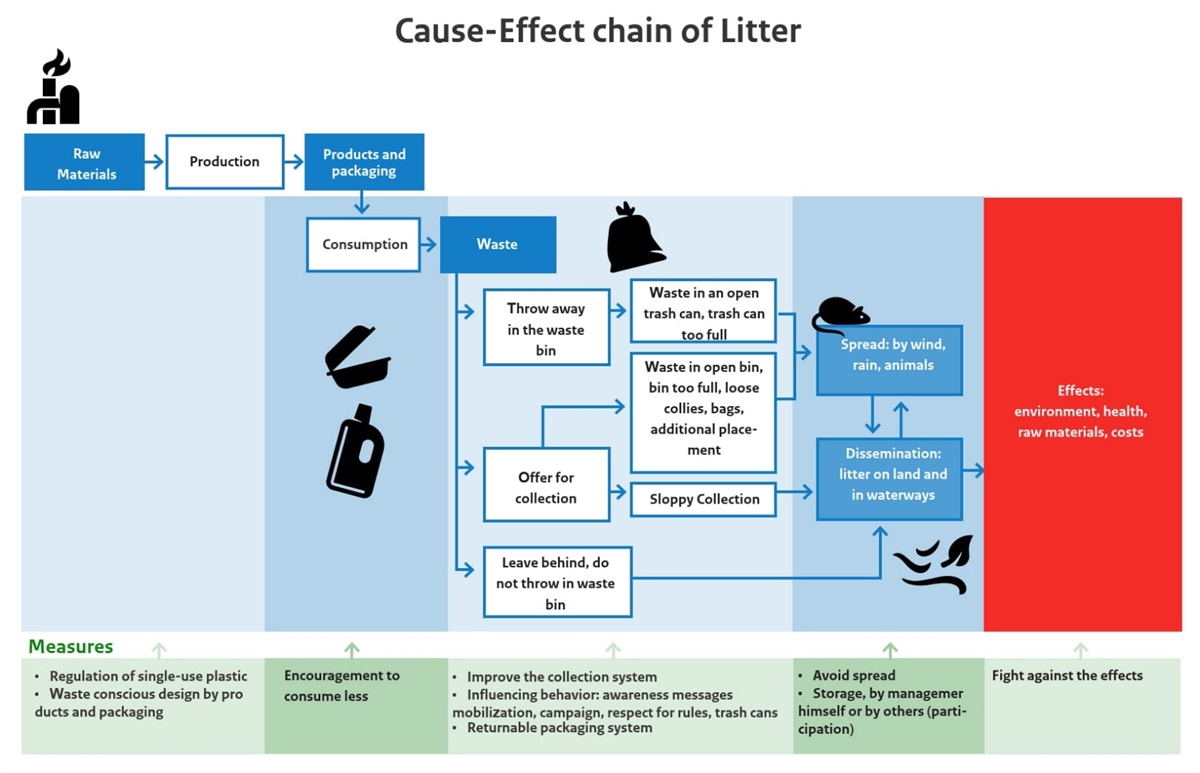How can plastic waste in rivers and their environs be avoided? That is what government agency Rijkswaterstaat is studying on behalf of the Dutch Ministry of Infrastructure and Water Management (IenW). We pass on our findings to area managers in the Netherlands and other countries, so that we can act jointly against those responsible for polluting rivers with rubbish.
Why are we tackling the littering of rivers and their surrounding areas?
Plastic waste pollutes our environment and damages nature. Plastic waste in rivers can flow into the sea, becoming part of the 'plastic soup' of pollution. If this waste has the opportunity to disintegrate into microplastics, the clean-up process will be more difficult. With regard to the transition to a circular economy, plastic waste is a stream of litter that must be prevented.
What does our strategy entail?
- We are developing a nationwide monitoring strategy for waste in rivers to be able to gather data reliably and cost-effectively. This strategy covers water-borne plastics of all sizes.
- We are developing a source-based approach, which will help us to identify the causes and sources of waste in rivers, consider procedures, conduct pilot projects and put the new working methods in place.
Image 1: Cause-and-effect chain for waste and measures taken against it
The image shows the cause-and-effect chain of waste and the impact it has on the living environment, health, raw materials and costs. It also shows the measures in the chain that can be taken against waste.

The image shows the cause-and-effect chain of waste and the impact it has on the living environment, health, raw materials and costs. It also shows the measures in the chain that can be taken against waste.
Monitoring of macroplastics in rivers
In the context of pilot (and other) projects we test and develop measurement procedures for macroplastics. This includes waste counting on river banks, monitoring of floating waste from bridges and interception of waste in the water column with nets. Apart from that, we study the use of various measurement technologies, such as waste identification, using a combination of cameras and artificial intelligence (AI).
Further information*:
- Bericht ‘Meetmethode beeldkwaliteit zwerfafval oevers vanaf het water (2022)’
- Bericht ‘Meetsysteem plastic: monitoring plastic in de waterkolom (2022)’
- Bericht ‘Voorstudie monitoringstechnieken zwerfafval grote rivieren (2022)’
- Bericht ‘Pilot monitoring drijvend zwerfafval en macroplastics in rivieren (2021)’
*Measures are drafted in Dutch, but may be translated with DeepL, Google Translate or Y; we are not responsible for any translation errors.
Monitoring microplastics in rivers
We also want to be able to measure the rise of microplastics in rivers and chart this over time. The procedures for both sampling and analysis of microplastics are still in the development phase. Initial results already indicate the quantities and sources of microplastics waste. Rijkswaterstaat is focusing on collaboration with partners at home and abroad. In this way we can obtain reliable data that can be compared internationally.
Further information:
- Video on our new measuring process (with English subtitles)
- Bericht ‘Op weg naar microplastics monitoring in rivieren’ (in Dutch, but can be translated with DeepL, Google Translate or Y; we are not responsible for translation errors).
Source-based approach to plastic waste in rivers
We can tackle plastic waste in rivers by addressing the root cause of the problem. We achieve this with an integrated approach and by striking the right balance between remediation and prevention. The Dutch Ministry of Infrastructure and Water Management has tested various measures aimed at preventing plastic waste ending up in rivers.
Below, we specify the main sources of plastic waste found on river banks and in the water. Furthermore, we explain the measures that area managers and other interested parties can take to reduce plastic waste in rivers. Among other things, easily visible rubbish bins and informative signs can be placed, waste filters can be fitted to intakes and the business community can be given appropriate guidance.
- Beaches Waste left by bathers, such as empty bottles, disposable cups and snack packaging. Learn more about possible measures here: Tips en interventies voor schone oevers, Zwerfafvalproblematiek op rivieroevers en uiterwaarden bij de bron aanpakken
- Building sites and business premises Small items of waste from loading and unloading terminals, storage areas at building sites and business premises on river banks. Learn more about possible measures here: Een schone bouwplaats: voorkom verwaaiing van bouwafval
- Inland navigation Waste from rubbish bags that are left next to rubbish containers and ripped open by animals. Learn more about possible measures here: Pilot Bijplaatsingen in de overnachtingshaven IJzendoorn
- Sanitary waste Sanitary waste containing plastics, such as wet wipes or menstruation products (via intakes and treatment plants). Learn more about possible measures here: Bureaustudie (sanitair) afval via riooloverstorten
- Competitive and recreational angling Waste generated by anglers who seek out remote places where there are no waste-disposal facilities in place. Learn more about possible measures here: Bronaanpak zwerfafval oeverrecreatie: eindrapportage
- Urban wharves Waste from beer gardens, catering venues, events and fairs, including empty bottles, disposable cups and snack packaging. Learn more about possible measures here: Clean urban wharves working method.
Sharing knowledge
Would you like to learn more about the topics on this page? Or perhaps you would like to share your own knowledge with us? Then send us an e-mail message to zwerfafval@rws.nl.